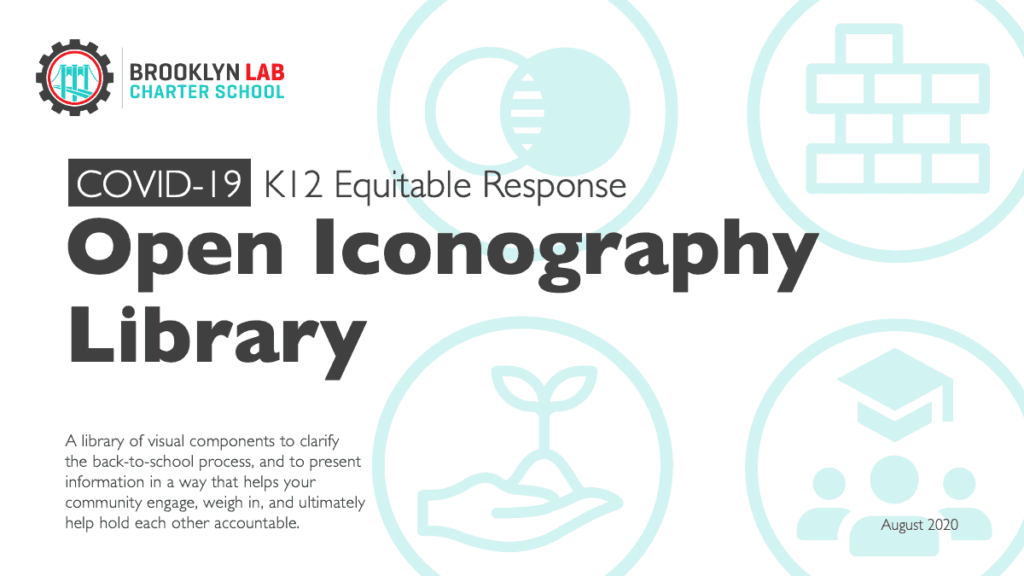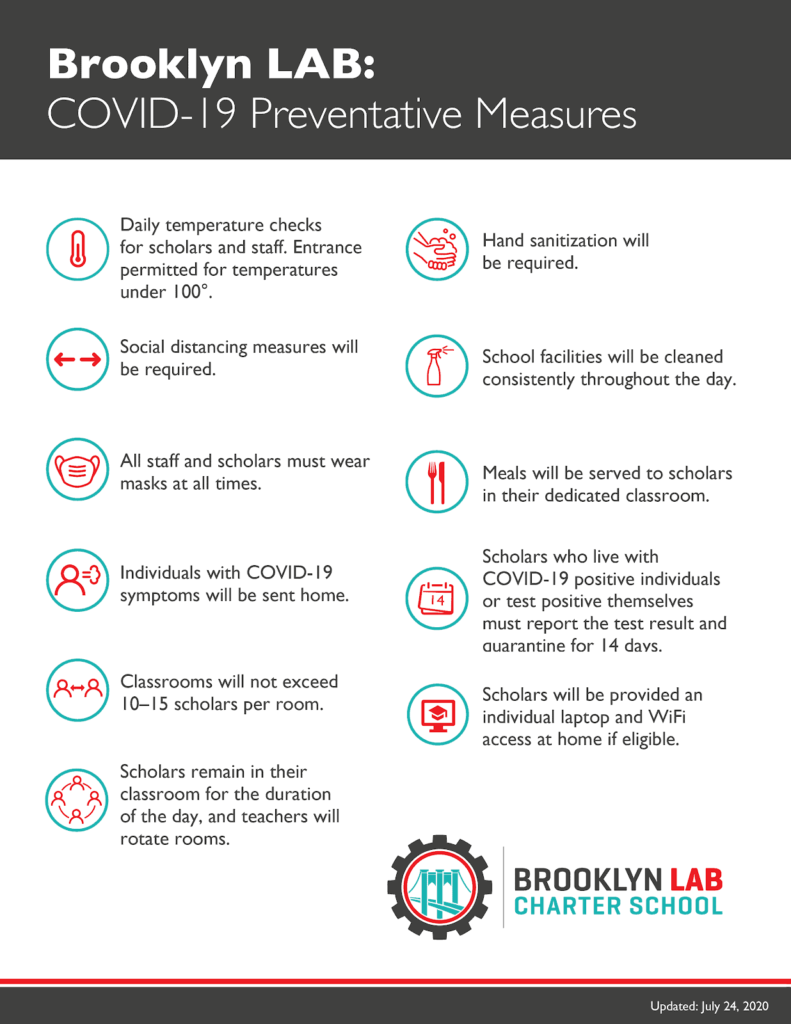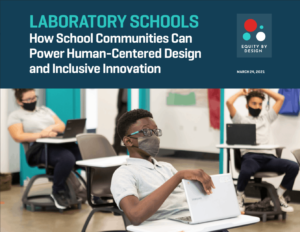The Story Behind The Laboratory School Open Iconography Library

As we strive to meet the challenges of education amid a global pandemic, sometimes it’s easier to show people how to adapt than to tell them.
That was precisely the thinking behind one of the latest COVID-19 response efforts at Brooklyn Laboratory Charter Schools (LAB), which opened its doors to scholars, faculty, and staff members for the school year on August 19, 2020 for our in-person orientations and on September 8, 2020 for the full slate of in-person instruction.
Given that we aim to serve all students—including the highest need students, regardless of their English language proficiency or disability—our push was to develop visual language to help clarify components of the back-to-school process for this unique year. The resulting COVID-19 K12 Equitable Response Open Iconography Library is a set of more than 325 circular icons that relate to safety in schools and support academic and social-emotional learning in the COVID-19 era.
Our goal with the library is simple: To present our thinking and information in a way that helps our school community to engage, weigh in, and ultimately help hold ourselves and each other accountable.
The resources were launched as a part of the “Facilities Planning in the Era of COVID-19 Guide,” and grew from our desire to ensure that all members of our school community — regardless of disability or language ability — can access and understand our plans to safeguard health, safety, and learning.
Of course, we also intend to share these icons for free with anyone who wants them.
We are not just putting these icons out into the world to be nice; we are encouraging broader use to advance a conversation about a public health response to the pandemic by introducing important questions about the school response, proposing potential solutions, and defining new concepts. It’s our hope that the icons will serve as a resource for schools that are trying to make their planning processes more open and accessible.
The icon library certainly didn’t happen overnight.
Earlier this year, Ashley Deal and Raelynn O’Leary formed a team of interns to work with Dezudio, their interaction and information design consulting firm in Pittsburgh, to get it done. The interns were former students in their class at Carnegie Mellon University, where they are also adjunct faculty.
Over the course of three months, the designers participated in numerous meetings and charrettes with LAB and other stakeholders to get a sense of what topics were key to organizing our response to the pandemic and what messages the school wanted to convey. They listened to public health experts talk about necessitating social distancing, hand hygiene, and face coverings. They observed as architects and designers worked through redesigning rooms and developing a new entry point for the school. They even interviewed teachers for more perspective on what sorts of logistical messages the educators are commonly trying to convey to students.
“It became clear early on that we needed ways to represent new and critical concepts in this space—things like different learning modalities, or changes to in-school practices due to the pandemic,” O’Leary remembered. “Conveying those important ideas visually helps people be able to ‘get it’ better than they do from written descriptions alone.”
 The Dezudio team built out a collaborative document with concepts and an inventory of icons as they sketched. The intern team referenced common representations in existing icons for general concepts, and explored a variety of possibilities for conveying new ideas.
The Dezudio team built out a collaborative document with concepts and an inventory of icons as they sketched. The intern team referenced common representations in existing icons for general concepts, and explored a variety of possibilities for conveying new ideas.
All told, Deal says the design process took about six weeks.
“Sometimes there was a clear concept—like, a hand means you’re offering something,” she explained. “Other times that immediate relationship is less established, and we had to find creative new ways to illustrate the concept.”
Some of the most challenging icons were those that dealt with complicated subjects, such as economic tumult or racial unrest. Other icons that proved difficult spotlighted topics such as food insecurity, trauma, and access to needs and services that are difficult to provide amid some of the new public health restrictions due to COVID-19.
Deal added that the process of creating the icons reinforced the importance of being clear.
“When you create a visual representation of an idea that’s supposed to appeal to everyone, it pushes you to be precise,” she said. “It’s easy when you’re writing to let things ramble. It’s something entirely different when you need to boil down an entire concept and instruction into one little icon.”
According to L. Arthi Krishnaswami, founder of the Community Success Institute and an adjunct professor at Carnegie Mellon University, LAB’s icons stand out because they’re unique.
“From an iconography and visual communications point of view, what struck me about [the library] is that it provides a structured set of visual representations for a complicated series of concepts,” said Krishnaswami. “Visual storytelling is an excellent way to bridge the gap between people who have a lot of knowledge and people who don’t—people who might not have a professional background related to some of the bigger concepts but who can benefit from them nevertheless.”
If anybody understands the importance of icons, it’s Krishnaswami. In her role as founder of Ryecatcher Education, a company that specializes in online collaboration software, she helped develop an iconography library specifically for special education. This library was released in 2014; many of the icons are still used by teachers who help students with IEPs today.
For Krishnaswami, the key to good icons is simplicity.
“You want to make information feel a little bit lighter when it’s heavy,” she explained. “Visual representation allows us to take the tension and frenetic energy down a little bit through different modes of communication.”
Now that the icon library has been released to the world, the next step is collecting feedback on the icons and tweaking the lineup accordingly. In this sense, the library is organic, ever-changing, and never truly “complete.” Considering how quickly things change in the world of education, this is probably a good thing. Considering how quickly things change in the time of COVID-19, it’s a perfect tactical approach.
For more, see:
- Preparing for a Healthy and Safe Return to School: Public School Facilities Planning in the Era of COVID-19
- Educating All Learners Alliance Launches Flagship Site, Shares Personas Educators Can Use to Understand Students’ Lived Experience During COVID-19
- Schools Need a Success Coach for Every Learner
- Preparing to Reopen: Six Principles That Put Equity at the Core
- To Reopen, America Needs Laboratory Schools
- How to Reopen Schools: A 10-Point Plan Putting Equity at the Center
- Reopening Schools: A Scheduling Map for Educators to Plan the Who, What, When, Where, and How of Learning this Fall
- The Front Porch: A New Approach to Support the Health, Safety, and Well-Being of Our School Communities
- Safeguarding Back to School: Preparation for a Healthy Return to School in Downtown Brooklyn
Stay in-the-know with innovations in learning by signing up for the weekly Smart Update.
We know that educators and leaders have spent the last couple of months scrambling to meet the immediate needs of learners in their community. Thank you to each and every one of you for everything you’ve done to make the best out of this challenging situation. Now that the end of the school year is here, we’re shifting our Getting Through series from stories and advice to support remote learning or long term closures, to getting ready for the complex work of reopening schools this fall.
Interested in contributing to this campaign?
Email your stories and ideas to [email protected] or tweet using #GettingThrough to participate!








0 Comments
Leave a Comment
Your email address will not be published. All fields are required.